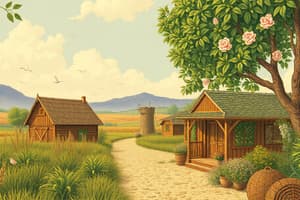Podcast
Questions and Answers
Agriculture had no contribution to deforestation.
Agriculture had no contribution to deforestation.
False (B)
Unsustainable farming practices can lead to soil degradation and fertility loss.
Unsustainable farming practices can lead to soil degradation and fertility loss.
True (A)
The Agrarian Revolution had a minimal impact on human societal structures.
The Agrarian Revolution had a minimal impact on human societal structures.
False (B)
Agricultural development potentially influenced local climate through factors like deforestation.
Agricultural development potentially influenced local climate through factors like deforestation.
Irrigation systems used in agriculture require little to no water resources.
Irrigation systems used in agriculture require little to no water resources.
The Agrarian Revolution was primarily characterized by a shift from settled agricultural communities to nomadic hunter-gatherer societies.
The Agrarian Revolution was primarily characterized by a shift from settled agricultural communities to nomadic hunter-gatherer societies.
The introduction of irrigation systems during the Agrarian Revolution allowed for farming in regions with minimal rainfall.
The introduction of irrigation systems during the Agrarian Revolution allowed for farming in regions with minimal rainfall.
Social stratification emerged as a result of the increased food production and specialization of labor during the Agrarian Revolution.
Social stratification emerged as a result of the increased food production and specialization of labor during the Agrarian Revolution.
Technological innovations in agriculture had no significant effect on productivity during the Agrarian Revolution.
Technological innovations in agriculture had no significant effect on productivity during the Agrarian Revolution.
The process of domestication during the Agrarian Revolution was limited only to plants and not animals.
The process of domestication during the Agrarian Revolution was limited only to plants and not animals.
The development of villages and cities was facilitated by the increased surplus food produced during the Agrarian Revolution.
The development of villages and cities was facilitated by the increased surplus food produced during the Agrarian Revolution.
The timing and characteristics of the Agrarian Revolution were uniform across all geographic regions.
The timing and characteristics of the Agrarian Revolution were uniform across all geographic regions.
The Agrarian Revolution had no impact on cultural development, including art and religion.
The Agrarian Revolution had no impact on cultural development, including art and religion.
Flashcards
Agrarian Revolution
Agrarian Revolution
The period of significant change where humans moved from hunting and gathering to farming.
Sedentary Lifestyle
Sedentary Lifestyle
Living in one place rather than constantly moving.
Agriculture Development
Agriculture Development
The act of cultivating crops and raising animals for food.
Population Growth
Population Growth
Signup and view all the flashcards
Specialization of Labor
Specialization of Labor
Signup and view all the flashcards
Technological Advancements
Technological Advancements
Signup and view all the flashcards
Social Stratification
Social Stratification
Signup and view all the flashcards
Irrigation Systems
Irrigation Systems
Signup and view all the flashcards
Deforestation's Role
Deforestation's Role
Signup and view all the flashcards
Soil Erosion Impact
Soil Erosion Impact
Signup and view all the flashcards
Climate Change Connection
Climate Change Connection
Signup and view all the flashcards
Increased Water Demand
Increased Water Demand
Signup and view all the flashcards
Long-Term Environmental Impacts
Long-Term Environmental Impacts
Signup and view all the flashcards
Study Notes
Introduction
- The Agrarian Revolution refers to a period of significant technological and societal change involving the development of agriculture.
- This process led to the transition from nomadic hunter-gatherer societies to settled agricultural communities.
Key Features of the Agrarian Revolution
- Development of Agriculture: Humans transitioned from hunting and gathering to cultivating crops and domesticating animals. This involved the deliberate planting of seeds, and the selective breeding of animals.
- Sedentary Lifestyles: With a stable food supply, communities settled in one place, establishing villages and eventually more complex settlements.
- Population Growth: Increased food production supported larger populations.
- Specialization of Labor: Surplus food production allowed some individuals to focus on activities other than farming, such as crafts, trade, and governance.
- Technological Advancements: The development of tools and techniques like plows, irrigation systems, and harvesting tools increased agricultural productivity.
- Development of Villages and Cities: Surplus food and resources facilitated the growth of larger settlements and the rise of civilizations.
Key Technological Innovations
- Plows: Improved soil preparation for planting.
- Irrigation Systems: Allowed for agriculture in drier climates.
- Domestication of Animals: Provided labor, food, and other resources.
- Storage Techniques: Allowed for the preservation of food surpluses.
- Tools for Harvesting and Processing: Made agricultural tasks more efficient and enabled larger-scale production.
Geographic Variations
- The timing and specific characteristics of the Agrarian Revolution varied across different regions of the world.
- Different regions adopted agriculture independently leading to unique agricultural practices and technologies.
- Factors such as climate, geography, and available resources influenced the development of agriculture in each region.
Impact on Society
- Social Stratification: Increased food production and specialization of labor created opportunities for social hierarchies. Some individuals accumulated more wealth and power.
- Political Organization: Sedentary societies needed more complex systems of governance to manage resources and conflicts.
- Cultural Development: Agriculture facilitated the development of art, religion, and other cultural practices.
- Environmental Changes: Agriculture led to deforestation, soil erosion, and other long-term environmental impacts.
Environmental Impacts
- Deforestation: Clearing land for agriculture contributed to deforestation.
- Soil Degradation: Unsustainable farming practices often led to the erosion and degradation of soil fertility.
- Changes in Climate: Agriculture likely influenced local climate patterns through factors like deforestation and altered water flows.
- Increased Water Use: Irrigation systems required significant water resources, potentially leading to water scarcity in certain regions.
Conclusion
- The Agrarian Revolution was a pivotal turning point in human history.
- It transformed human societies from hunter-gatherer nomads to settled agricultural communities, leading to population growth and the eventual rise of complex civilizations.
- The changes in lifestyle had both positive and negative impacts, which continue to resonate today.
Studying That Suits You
Use AI to generate personalized quizzes and flashcards to suit your learning preferences.




